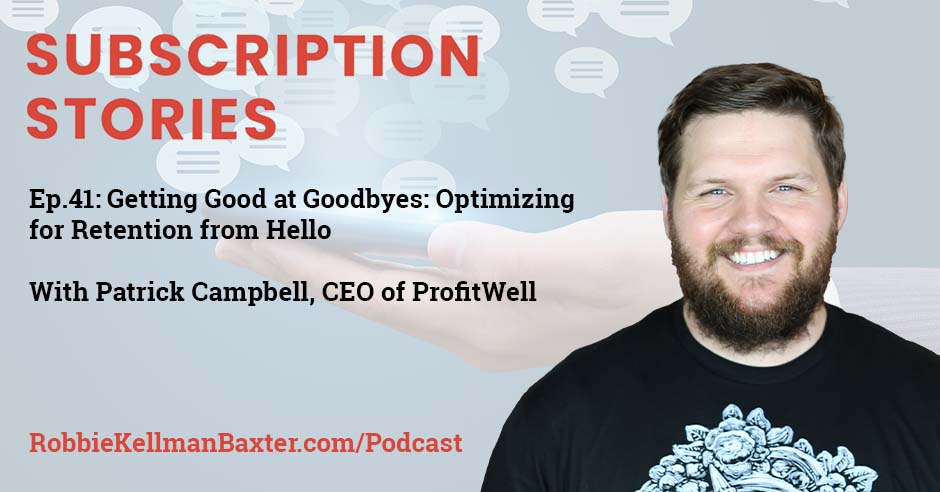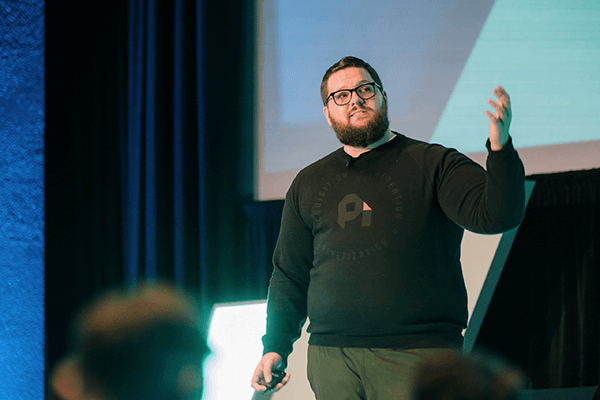
Most subscription-based businesses focus too much on acquisition and not enough on retention. But actually retention improvements are usually more effective, both for total revenue AND profitability. Today’s guest Patrick Campbell couldn’t understand why so many organizations weren’t doing the math, and so he started his company ProfitWell to help companies better manage churn. Patrick says you have more churn levers than you think. They include how you target prospects, onboard subscribers, support engagement, and of course what you say when they are getting ready to leave. And did you know that one of the best places to look for new subscribers is in your list of former subscribers? In today’s episode, we’ll show you how to optimize your subscription for fewer and softer Goodbyes… from the moment you say Hello.
—
Listen to the podcast here:
Getting Good at Goodbyes: Optimizing for Retention from Hello With Patrick Campbell, CEO of ProfitWell
Most subscription-based businesses focus too much on the acquisition and not enough on retention, but retention improvements are usually more effective both for total revenue and for profitability. Our guest, Patrick Campbell, couldn’t understand why so many organizations weren’t doing the math, so he started his company ProfitWell to help companies better manage churn.
Patrick says you have more churn levers than you think. They include how you target prospects, onboard subscribers, support engagement, and of course, what you say when they’re getting ready to leave. Did you know that one of the best places to look for new subscribers is in your list of former subscribers? In this episode, Patrick and I talk about how to optimize your subscriptions for fewer and softer goodbyes from the moment you first say hello.
—
Patrick, welcome to the show.
Thanks for having me. I love your content, so I’m glad that I can be a part of it now.
I’m very excited to talk to you because churn is probably the hardest thing for subscription practitioners to figure out. It’s so complicated and it’s something you’ve been thinking about for a long time. I’m wondering what prompted you to build a business, Profitwell, around churn or around keeping subscribers.
There are thousands of products for acquiring customers. There are next to no products for monetizing them and then there are very few products for retaining them, so we thought, “Let’s not be another one of the 6,000 companies for acquiring customers. Let’s try and have these high leverage areas and build some products.” That sounds probably great, nice, and clean, but it was a lot more complicated and all over the place over the years. To be intellectually honest, it’s a little more complicated.
As you make an experiment, you realize that it has some good parts and some bad parts. And just like anything else, you should be optimizing that continuously. - @Patticus Share on XMonetizing and keeping subscribers, you have so much data about subscriptions, subscribers, and the companies that you work with. Can you share a few nuggets that surprised you when you first saw them?
A lot of the stuff that’s plaguing a lot of businesses, and I use that very loosely, is pretty fixable, and to be very specific, things like credit card failures. If you’re a credit card-based subscription business, which there are a lot of those, it typically is about 20% to 40% of your lost customers, so if you lose 100 customers, 20 to 40 of them are because of payment failures, which is pretty out of control. That’s why we started building our Retain product to start there. This is a purely mechanical problem and it’s a problem that plagues all of these businesses.
20% to 40% is a big number of people who didn’t actively want to leave.
A lot of our views on growth, particularly in the subscription space, are more instinctual or more feeling-based than looking at the data of what works and what doesn’t. It is important because the value of your product is hard to measure and is also one of those things that are going to take a long time to get the right features, the right customer, and all these other things. There is all this more data-y mechanical stuff that can be fixed to buy you more time, essentially. It is not an either-or thing. It’s more of you got to be doing everything.
If I were going to summarize what you said, separate from the unique strategy of your subscription business, whether you’re offering a software product that’s B2B or a consumer media offering or talk of the month club, there are shared hygiene rules that can make the difference for any subscription business, and if you’re not doing those, you’re leaving money on the table and you’re making it harder for your subscriber to get value. There’s no reason not to do these things.
There are a couple of prefaces to answer that question. I know that this is a subscription-oriented show, so a lot of people are probably already aware, but to make sure we’re on the same page, the beauty of the subscription model is that it is the first commerce model in the history of humankind where the relationship with the customer is built into how you make money. I don’t have to convince you to keep coming back each week. I don’t have to convince you with a coupon because you’re going to go to the store across town. As long as the value is still there, presumably, I’m going to stick around.
With that thought aside, the other thing to keep in mind is that the beauty of the model from a technical standpoint is you’re always theoretically improving the value of the product. You’re shipping new features. You’re getting better at your bug fixes. Depending on the type of product, you’re making that company more money or you’re saving that person more cost. There is this relationship that is much more equal than it used to be. All of a sudden, consumers probably still have more power, but it is a little more equal. The reason I say that is because there are so many different things that influence the value of your product besides just the price point.

Optimizing Retention: The beauty of the subscription-based model from a technical standpoint is you’re always theoretically improving the value of the product.
When we talk about monetization and experimenting with monetization, the answer to your question is the best companies in the world are shipping some sort of pricing experiment every single quarter or every three months. That does not mean they’re raising their price or lowering their price every three months. What it means is in one quarter, they raise the price because they haven’t raised it in a year. You can only raise your price probably once per year because even if you have the best product and you’re shipping so much value, it’s a little rocking the boat to your point. In the next quarter, they’re doing localization and putting different price points in different regions around the world because everyone has a little bit of a different purchasing power. Netflix is one of the best companies in the world at this. Every single region has a different price. Evernote has 120 different price points across the world. It is crazy.
The next quarter after that, they’re like, “We’re going to take this feature out because not everyone uses it, but the people who use it get a lot of value from it and it looks like they’re willing to pay for it so we’re going to make that into an add-on.” All of a sudden, their revenue per customer is going up. The thing I would say is the best companies are doing something every three months, but the reason is because anything that influences your revenue per customer, your ARPU, ACV, etc., is a pricing experiment. Those are the things that I would focus on. The reason a lot of people don’t do this is because they’re scared. They don’t realize there are so many other things they can do besides raise the price.
You have these most brilliant business people in the world, but pricing sits at the intersection of uncomfortable and important, and whenever you have something at that intersection, everyone gets a little squirrely because they don’t want to make a mistake, but as you make an experiment, you realize, “That experiment had some good and bad parts. Now, let’s fix this part and experiment with this.” You should be optimizing anything else in your business pretty continuously.
If a company was saying, “We haven’t changed our price in five years. What do we do first?” Let’s say that they’re not global, because, by the time you’re global, you may also already have a pricing expert on the staff because you’ve reached a certain size if you’re thinking about pricing by region. Let’s say that you’re in one country or in a particular market and you’re trying to figure out those other things, like the specific seekers, the ARPU, and all of that. Where would you advise them to start?
I would start with either evaluating your value metric. It is how you charge per user, per thousand visits, especially if you are a B2B product, but if that’s a little bit of a harder lift or you are more of a consumer product, I would start with what’s an add on that we can sell. It might be a feature you pull out of your existing plan and make a separate subscription price for or it might be something where you’re like, “Everyone keeps asking for this. It’s not going to be in the core product,” and go from there. Both of those have very time-boxed and also high-impact changes.
Value metrics are a little bit scary and a little bit harder to change, whereas things like add-ons are easy because it doesn’t affect anything. You can send a marketing email or something like that. Honestly, most companies are global, and I will go out of my way to say that the best starter project is typically price localization even if you’re a small company with only about 20% of your base outside of your home region. The reason is because it’s a tight thing to research. You can be like, “Our price in the US is this. Our price in Europe is this. Our price in the UK is going to be this.” You don’t have to change anything about your billing system. You don’t have to argue about features. You don’t have to do anything. It’s a straightforward exercise. If you have a very low politics culture, then you can go after, “Let’s raise our prices.”
To summarize, you’re saying, number one, even if you’re a relatively small company, you probably have a global presence. That’s a great and low-stakes place to start experimenting with pricing strategy. Over time, you can experiment with the value metrics, how you are going to price and based on what and who are your best customers. Also, it is always easy to offer something new and charge a little more for these add-ons. It is to say, “Tier one is our core product. If you want the new feature, you’re going to pay some extra fee.” That way, nobody feels like their price is going up on them, but if they want the additional value, they’re going to pay more.
Off boarding is one of the most underutilized pieces of any retention strategy. - @Patticus Share on XWhat I used to say is, “Start with your personas, profiles, or segments.” The entire point of your business is to drive a person or a segment to a point of conversion and then justify that price in that product, and if you have no idea who that person or that segment is, there’s no way you can set up your pricing let alone efficient funnels. That’s the real starter answer, but I want you to get some momentum before you do broader research because it’ll get the team on board with more research.
You’re saying that the work that they don’t want to do or that takes a long time is the customer segmentation or persona development work. You’re saying that even before you have that information, you can start tinkering with your pricing around regions, around new features, and potentially even around the pricing for the value concept that you use.
You just need some momentum. If there’s any product people or marketing people reading this who are like, “I know we need to fix our pricing but I can’t get these folks on board,” start with something concrete as we talked about because when you go in and try to transform the whole company, people feel like the stakes are too high. In reality, they’re not, but people feel the stakes are too high, so start with something where you can get some momentum, and then you start getting addicted to answering more questions and getting more changes. All of a sudden, you have a full-time pricing person working there because there’s enough leverage in that lever for them to use.
It’s the same philosophy as onboarding a new subscriber. You don’t have the privilege of telling them all the things that your product can do until they fall in love with that first headline benefit or the first thing that brought them in and get the value. The first thing you do is you give them value, and the second thing you do is show them more ways to get value rather than saying, “Welcome. Sit down for the next hour while I walk you through every single feature that we have before you even get value.”
This is a very common thing I would say for products as well, like any product team. You try to change the behavior of your customer. Our customers are operators at subscription companies. Even if I convince them, “If you look at this lever, it’s so much more effective than this other lever,” they’re still like, “Yeah, but I’m still going to spend 60% of my budget on the acquisition, sales, and marketing on that lever,” which is fine. I don’t think people should spend less. They probably should be spending more, but it’s like, “You should do that and this other stuff.”
This is why we’ve evolved in making it easy. This is also why we’ve set up our Retain product. We call it Anti-active Usage. It’s more passive. You just set it and forget it. You don’t have to tweak anything or set anything up. If you’re relying on active usage, you have to be in the person’s workflow or you have to be something that’s so entertaining that they keep coming back. Most of us are fighting for that. We’re not that type of product, so we should do it for them. That is where the next wave of a lot of subscription products are going, both from the consumer side and the B2B side.
You’re picking on acquisition as a growth lever.

Optimizing Retention: A lot of the views on growth, particularly in the subscription space, are more instinctual or more feeling-based than actually looking at the data of what works and what doesn’t.
First off, the most important thing I would argue, and I am not a good person to expound on it, but I can see it in the data, is onboarding. Onboarding is the thing that you should spend your time on. The way I look at this, and to maybe back up a second, is there is strategic retention and then tactical retention. What I mean by that is strategic retention is what most people think about when they think about retention. Do we have the right features? Do we have the right onboarding? How does our support look? How are we fixing bugs?
The largest bucket in that group is typically onboarding because you want to get people that moment of delight or that moment of value that you want the time to value to be really small. This is why you need a good product team because, as you already alluded to, they’re not always going to have the best understanding when it comes to what goes on with those users. All of a sudden, you have all these hundred different types of users and their fragments. Which ones are the best ones? Which ones are the worst ones? That takes a strategic brain and someone banging their head up against the wall studying all types of data and then making an instinctual decision. First, have a good product person or product team.
The biggest mistake I see is people allow growth to drive product too much, or the product is basically project management and the CEO is doing the product. You need someone who’s going to argue, sweat, and say no to every decision when it comes to product. That’s the type of person you need. Those people aren’t necessarily cheap. That’s where I would spend some money.
On the tactical side, this is where I would spend more easy money or quicker money, and these are things like credit card failures. You’re offboarding, which we can get deep into. Offboarding is one of the most underutilized pieces of any retention. It’s how people leave, which is the big theme of this show. The last thing is around reactivations and term optimization, which I alluded to before. These are four mechanical things that, even if you implement them in a crude way and have basic things implemented, I guarantee that your churn will go down.
It’s credit card failures or delinquent churn. If you’re an invoice product, meaning that’s how you make most of your money, it is still a problem but not that big of a problem, credit cards are still a pretty big problem. Even ACH has a problem. You’re offboarding, how do people leave? What do you do when they leave? Those include salvage offers. Reactivations, which is someone who has left and you’re trying to get them back. You’d be amazed at how little companies do even though people leave for reasons that have nothing to do with you all the time. The final one is term optimization. How do you get shorter-term customers from monthly or quarterly plans onto annual plans or even two-year plans depending on the type of business you are?
Those are the four pillars of tactical retention. If you get those taken care of, you can solve up to about 40% of your churn problem. It’s not going to be the majority, but the cost it takes and the time it takes to implement those things, it’s like you set it up then you don’t have to touch it, and it pays dividends over time. There’s always more you can improve. That’s the thing I would have a lot of people think about. The strategic part with that good product person is death by a thousand paper cuts. The other stuff is we can take a couple of weeks and implement the basics and it’ll pay dividends for a long time.
Let’s go through those in a little more detail because this is gold. This is what people struggle with. Credit card failure is pretty mechanical. You just need a system that solves some of those credit card failure issues. Offboarding is a term that I don’t hear very much. What is offboarding?
When you start dating someone, the beginning is great. But if it doesn't work out, the way it ends is also pretty important. - @Patticus Share on XTo use an overused metaphor, when you start dating someone, the beginning is great, but if it doesn’t work out, the way it ends is also pretty important. Maybe you’re not going to be friends, but you don’t want to leave that person hating you. Sometimes, that’s unavoidable. Offboarding is when someone hits that cancel button or sends an email to support saying they no longer want the product or calls in, and I don’t think you should force people to call in, but you should still allow people to call in to cancel, what does that process look like?
It’s not as important as onboarding, but again, it’s more tactical so we can implement some very cool things. We’ve got a lot of data on this that I’m sure I can share on what that looks like of how to save as many people as possible from canceling. that’s what you’re trying to do with good offboarding. You make sure that not everybody leaves who hits that cancel button.
A big part of offboarding is actually not offboarding them at all. It’s saving them. That’s one part of offboarding. When somebody says, “I’d like to cancel,” it’s understanding why they want to cancel and maybe removing some of the drivers for that. If they say, “I’m not using it enough,” say, “We have a smaller offering.” If they say, “You did something that made me really mad,” you say, “Let’s fix that. Let’s do something to accommodate you. Thank you for telling us.” One part of offboarding is keeping them. When the person says, “I want to break up with you,” you say, “Let’s give it one more chance. What can I do to save this?”
I’ve heard you talk, though, also about what I think is true offboarding. Sometimes the reason that a person wants to leave is both valid and not related to anything you could have controlled, like, “I’m leaving the gym because I’m moving across the country. I broke both of my legs in a car accident and I don’t want to pay when I can’t get to the gym. I’m getting PT already, which takes the place of it for several months.” How do you handle that part of offboarding when it does make sense for the person to leave?
Let me explain the best offboarding flow or at least what we found in the data. This is not only for saving folks. It’s for learning. If you don’t understand why people are leaving or why people love you, you can’t fix those things. The natural question that everybody has, which is great, is why are you leaving? You should ask that. I don’t think it should be a free-form response. The people that are leaving don’t necessarily want it. Some people would give great feedback, don’t get me wrong, but you can follow up to get that deeper feedback. I like to give them 4 to 6 options. Those 4 to 6 options won’t be worded as I’m about to say, but they should relate to what I’m about to say.
It could be something like, “I’m no longer using the product, but I’ll be back. I didn’t see the value. You were missing a key feature.” You might word these a little differently depending on your type of product, but these things are very notable why they’re leaving. You’re going to take that data, give it to your product team, and your product team is going to scrutinize it and maybe follow up with some people with like, “Can you tell me more?” It also could be like, “Do you mind getting on a call?”
Some of those things also might be like, “I couldn’t get a support or sales question answered.” What most offboarding then does, and not everybody has this, 30% is generous, a lot of consumer companies do this because it’s a good best practice, but naturally what then happens is people go right to an offer after that. They’re like, “Stick around for $10 off.” That’s the wrong thing to do or at least it’s not the optimal thing to do.

Optimizing Retention: By experimenting with pricing, you learn what works and you evolve with this rapidly changing market and the new competitors.
The next question I want to ask, and this is just the second question, is, “Why did you stay? What did you value about the product?” These are things you can say, “They fixed my features. I got so much value from it.” There are a lot of options you can give again, but the reason I asked that question is because the next thing I’m going to do is I’m going to say something along the lines of, “Considering you really loved our features, but you are leaving because you’re not using it right now, why don’t we get you on a pause plan?” I’m going to tailor that offering depending on what they said.
If they say something like, “I didn’t have enough time to see the value, but I liked your features,” I am going to go, “Why don’t I give you a free month?” If they’re like, “You’re a product that has real costs,” I might be, “Why don’t I give you $10 off this next month?” If they’re like, “I didn’t have a chance to talk to support, but I love the features,” I’d be like, “Here’s a Calendly link. Let’s get you scheduled with support, and let’s ‘save’ you.”
There are a couple of things going on. Something that I noticed that is interesting to me is when you were talking about the choices of why I’m canceling, you didn’t say it’s too expensive, because 9 times out of 10 if you give a free response, that’s what people say, which is like the romance of saying, “It’s not you. It’s me,” which is not true.
Also, if you give them that option in multiple-choice, people will go to it. With value, if something’s valuable enough, you pay for it even if someone next to you won’t pay for it because they don’t see the value, so saying something like, “It’s too expensive,” is like a secondary emotion. It’s like, “Why is it too expensive?” They’d be like, “You didn’t have the right features. I didn’t have enough time to use it.”
I didn’t state this, but the reason the whole why did you stay or what did you value question is so important is because it serves two purposes. One, it helps your product team figure out like, “It turns out we’re doing well here.” The other thing is it causes this phenomenon that’s almost like a senioritis phenomenon, like, “It wasn’t that bad. It was great.” It reminds them that there is some value there. Most people who are leaving are not leaving because they’re aggravated. It’s a very small portion that those are the ones that we fixate on, but for a lot of people, there’s something that you couldn’t recognize because you have such fragmented user bases that you need to break through that somehow when they’re leaving.
Then, you can make offers. Maintenance plans are something that’s underutilized even in the consumer space. You can be like, “You’re leaving? What if you paid $5 a month so we save all of your data or save all of your settings?” I’d rather have that than a full churn because then I can send them emails about it, and as soon as they come back and start using the product again, I bump them right back up to the fully paid plan. We also learned a lot about pause plans. Salvage offers are a month free, $1 off, or $10 off. They’re these types of things, and then scheduling with support or scheduling with product to talk through things. All of these types of things incrementally lower your churn. This product’s in early access. We’ve worked on it a long time but we’re finally releasing it. We’ve seen even with the most basic things like people who can’t fully implement it, lower churn rates by 20%, and people who are fully implementing, we’re seeing cancellation rates dropped by 35% or 40% in some cases.
You’re saying that by having a better offboarding flow, which is trying to salvage what you can, try to understand specifically why they’re leaving and have some remedial offer or experience to try to shore up some of those holes. If they’re leaving because of a support issue, you get them to support right away. If they’re leaving because they’re not using it enough, you come up with a lower-priced or lower value offer. You’re saying that the organizations that do that are the ones that enjoy that almost a tactical bump in retention.
Awareness is the hardest part of growth. - @Patticus Share on XIf you have terrible retention to begin with, meaning your pre-product market fit is they say, nothing I said is going to help you.
That follow-up question, which is why were you here? What value did you get? This is what I think is so interesting. They might say, “I came because your pitch was good but your product itself isn’t as good as you promise. It doesn’t work or it doesn’t have the features I need” In that case, you don’t want to retain them because you can’t deliver on your promise. You need to go back to the drawing board, but what you’re saying about offboarding is for a lot of people, when you have product-market fit and the customer is leaving, it’s important to understand the reason and see what you can do to mitigate the problem, and if they go, which leads into your next point, you want them to leave in such a way that they don’t have a bad taste in their mouth.
Two questions where you offer something to save them and your language is hopefully helpful, there won’t be a bad taste in their mouth. There are the purists out there who are like, “Let me cancel,” and that’s it, or like, “Don’t get in front of me.” You had a relationship with this person. There’s going to be someone who’s very upset. I ignore those folks. Unless it’s a very large number of people complaining, then I look at what’s going on. Also notice that we’re not forcing someone to make a phone call. I think that’s a big mistake.
Let’s say 100 people leave. They didn’t get saved through offboarding. 100 people are gone. Over the next twelve months, the average subscription company is able to get, depending on the type of vertical they’re in, somewhere between 20 and 40 of those folks back, because again, even if you didn’t get a lot of them with a salvage offer, they know you. Awareness is the hardest part of growth. That’s why we spend so much money on acquisition. All of a sudden, they’re sitting there and they’re like, “I do have that thing I need. I remember I used it. Let me check it out again.” There’s that feeling, but what we found is when people don’t offer some ability to self-serve, they cancel. All of a sudden, that reactivation number plummets. The plummets are somewhere 5% to 10%.
I think what’s important for the audience is they need to have an offboarding flow. You need to ask them why they left and you need to try to make it right for them if there’s something you can make right, and if you can’t, you want to let them go as easily as possible. You don’t want to require them to call you between 4:00 PM and 6:00 PM on odd-numbered Tuesdays. You want to make it easy for them to leave so that you get that 40% of cancels back at some point in the future so that you can reactivate them later.
To maybe close the loop on reactivations, it’s pretty straightforward. You just have to email them and maybe offer an offer of a certain dollar amount off or some sort of trial, but a lot of people do not email the people who know about your product and left not necessarily because of you. Those are the best people to email. Thankfully, the volume is not going to be the biggest. It’s not like emailing your marketing list, but it’s a very good segment for you to go after.
One thing that happens is a reminder, like, “We’re still here when you’re ready for us,” and another one is, “You left because we didn’t have this feature, and now, we have this feature.” They already understand what your value is, so that’s an important point that you bring up about reactivations. The last one that you talked about is the term optimization. I get questions about this all the time. They’re like, “Should I have monthly? Should I have annually? Should I require people to be annual? Should I only have annual? What about quarterly?” How do you think about both figuring out what’s right for your organization and then encouraging your subscribers to commit to longer stays?

Optimizing Retention: The reason a lot of people don’t do a pricing experiment is that they’re scared. But pricing sits at the intersection of uncomfortable and important.
The first part of what you said on whether you should force them into annual, you can do that unless you have a product that has heavy inside sales, meaning it’s a new multi-call close at least and it’s a product that takes time to set up. I think about HubSpot. For me, to set up my CRM or my marketing automation and I’m not using the free tools, but I’m buying the proper core HubSpot platform, it’s okay to charge me annually because it’s going to take me two months to set up and then it’s going to take me another three months to see the value. I’m committing as a customer to a value relationship. You are committing to like, “We’re not going to screw this up. I’m showing you through all my sales and getting the sales engineer on the phone and everyone involved about everything that’s going on.”
That’s okay. Most of us are not that. Most of us think we’re that, and then most of us are like, “There is a use for monthly,” or, “There’s use for quarterly,” or, “Our buyers are more comfortable with that,” because again, a monthly product is almost trying out the product. It’s like you’re giving them a chance to try it out before they make a bigger commitment, and the biggest mistake I see with people trying to optimize for a term is the only time they ask someone to be on a longer-term plan is when they first sign up.
To use the overused dating metaphor, it’s like, “I’m not going to get married to you on the first date or commit to moving in with you. I’m going to want to go on a few dates. I’m going to want to use the product for a month or whatever it ends up being.” The best way to do this is to identify whether it’s B2B SaaS. These are typically customers who are 2 months in or 1 month plus in up to about 10 months. Normally, if it’s subscription eCommerce, it’s the second month up to maybe about 4 or 5 months. It’s where your LTV starts to drop off. When you start seeing that drop-off, that’s when I want to have different campaigns that go out maybe every other month and offer them some discount.
The discounts are important here. People discount way too much. Normally, people who like the product are looking for a sweetheart deal or looking to get in the door, so I would start with one month if you’re a B2B SaaS company. Some B2B SaaS companies go for six months right away. I’d start with one month and maybe ratchet that up to two months, and make sure you phrase it as months. Oftentimes, people don’t understand percentages when it comes to discounts. We see this in the data. Offer two months versus the percentage equivalent. This is a study that has been done in retail for many years now, but it works in SaaS and subscriptions as well.
To summarize, because this is very specific and useful information, you’re saying you can certainly offer the discount for the longer commitment upfront. It’s to say, “It’s $15 for a month or $100 for the year,” but you want to offer it again a little bit later when they’ve both had a chance to get to understand your offering, and also at that moment where a lot of people are starting to drop off, that’s where you want to introduce these other offers.
When you make those offers and you’re trying to explain the value, and if the value is not an additional functionality when you’re an annual subscriber, you get X, Y, and Z, but if it’s about a discount, you don’t say, “You get 10% off,” because that requires me to think. You say, “You get two more months for the same price. You get 2 or 3 free months.”
That’s the exact point. We don’t understand percentages as humans. It takes us a second. If you give me $10 off, I’m like, “I know it’s $10.”
We don't understand percentages as humans. It takes us a second. If you give me $10 off, I'm like, “I know it's $10.” - @Patticus Share on XThere’s a lot more that we can cover. You have a tremendous amount of content that you create yourself and that the ProfitWell team has. I encourage people to go check it out and check out your product because basically free money. It’s passive churn. Putting these kinds of systems in place is something that organizations should really take a look at. Before I let you go, I want to see if you’re willing to play a quick round of speed questions.
Even my answer to that is not the shortest, so I’ll try to be short as possible.
What’s the first subscription you ever had?
It’s probably my cellphone. My phone number is also the longest subscription I have ever had, so that’s exciting.
What’s your favorite subscription now?
I love my WHOOP. It’s the first fitness product that got me to do stuff I needed to do.
What’s one place you really want to go on your upcoming North American van tour?

Optimizing Retention: You don’t have the privilege of telling them all the things that your product can do until they fall in love with that first. The first thing you do is you give them value. And the second thing you do is show them more ways to get value.
We’re doing a van tour. I have a camper van that’s branded. I want to go to Fargo and Kansas City. These cities have big subscriptions and SaaS communities, but no one visits them because it’s Fargo and Kansas City.
Those are great places, by the way. I’ve been to both places.
That sounds great from a vacation perspective.
The last question is, what’s one piece of advice that you want people to take away from our conversation? If there’s one thing that they remember, what would that be?
Done is better than perfect on mostly everything. It’s never done. Nothing’s ever going to be done. It’s one of those things where it’s okay to do a basic version of some of the stuff we talked about and then come back to it a year later and then realize that you’re going to have to do a lot of little things and build time. That sentiment is what I’d want people to leave with.
That’s very wise. Done is better than perfect, so get in there and start experimenting. Thank you so much. This was phenomenal. There was so much information and wisdom on pricing, onboarding, offboarding, reactivation, and managing churn. I appreciate you taking the time to talk to us.
Thanks for having me.
—
That was Patrick Campbell, the Founder and CEO of ProfitWell. For more about Patrick and about ProfitWell, go to ProfitWell.com. Also, if you like what you read, please go over to Apple Podcast and leave a review. Mention Patrick and this episode if you especially enjoyed it. We read all the reviews because we want your feedback. Thanks for your support and for tuning in to the show.
Important Links:
- Patrick Campbell, Founder and CEO, ProfitWell
- ProfitWell
- Stripe
- Zuora
- Recurly
- Paddle
- Chargify
- Retain
- Netflix
- Evernote
- Calendly
- HubSpot
- WHOOP
- Apple Podcast – Subscription Stories: True Tales from the Trenches
- ARPU
- ACV
About Patrick Campbell
 Patrick Campbell is the Founder and CEO of ProfitWell, the suite of tools that plug right into your subscription management system and provide turnkey solutions to reducing your churn, optimizing your pricing, and ensuring your revenue recognition is audit proof. ProfitWell’s flagship metrics product also powers the subscription financial metrics for over twenty thousand subscription companies (it’s free and takes less than five minutes to set up – seriously). Prior to ProfitWell Patrick led Strategic Initiatives for Boston based Gemvara and was an Economist at Google and the US Intelligence community.
Patrick Campbell is the Founder and CEO of ProfitWell, the suite of tools that plug right into your subscription management system and provide turnkey solutions to reducing your churn, optimizing your pricing, and ensuring your revenue recognition is audit proof. ProfitWell’s flagship metrics product also powers the subscription financial metrics for over twenty thousand subscription companies (it’s free and takes less than five minutes to set up – seriously). Prior to ProfitWell Patrick led Strategic Initiatives for Boston based Gemvara and was an Economist at Google and the US Intelligence community.
Love the show? Subscribe, rate, review, and share!
Join the Subscription Stories Community today:


